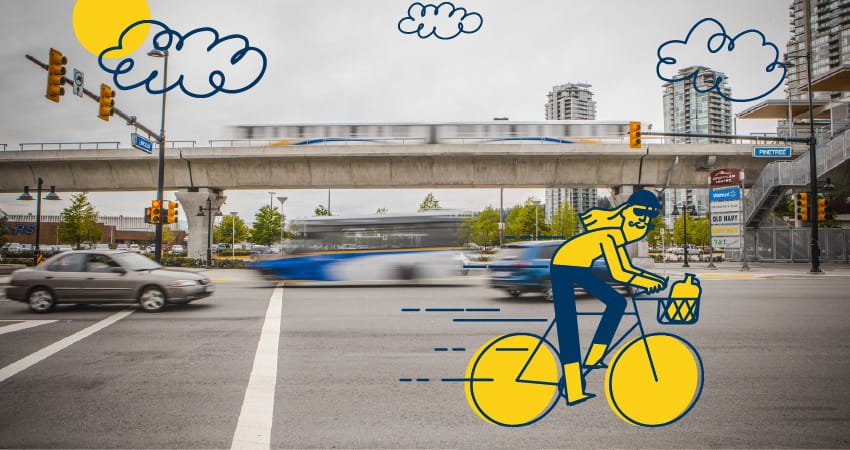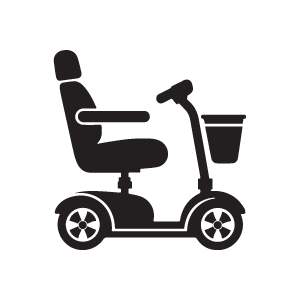Bikes on Transit

You can take your bike on almost all transit services, including bus, SkyTrain, SeaBus, and West Coast Express, with some restrictions. More information on our bike parkades and other short-term storage options, is on our Bike Parking page.
Bike Parking
Cycling to a transit station is a great way to commute.
Bike to Transit
Getting from point A to B is easier with a bike in the mix. Cycling can be the fastest way of getting to and from key transit hubs. It's also healthy, good for the environment, and fun! Learn how to integrate cycling into your trips around Metro Vancouver.
Bikes, E-Bikes & Scooters on Transit Modes
Our goal is to make transit accessible for everyone. If you bring your bike, e-bike, or scooter on transit make sure that it is safely under your control, does not block aisles or seats, and does not get in the way of others getting on or off the vehicle–especially when it’s busy. Please observe the following rules when bringing your bike or scooter on transit:
-
Bikes, electric bikes, e-scooters and folding bikes are permitted on bus, SkyTrain, SeaBus, and West Coast Express services, with some exceptions. Depending on the time of day or how busy the bus, train, or vessel is, there may not be room to accommodate your bike.
-
We do not allow seated electric mopeds/e-scooters, motorbike-style e-bikes (electric, or gas-powered) or bike trailers on board any transit vehicles.
-
Electric foldable scooters are permitted on board all transit vehicles at the discretion of transit operators based on customers safety. We ask that you fold and store your e-scooter while using transit to ensure the safety of all customers.
-
Riders are responsible for their bike at all times, including loading and unloading bikes from racks on buses. TransLink is not responsible for any damage to you or your bike caused by loading or unloading bikes.
-
All bikes and other mobility devices must be clean and have no sharp edges that might cause damage or injury.
Service-specific rules about bringing your bike or mobility device onboard apply – please review the rules for the service you are using below.
Bikes
-
Bus: Yes, on the bike rack (Two spaces per bus)
-
SeaBus: Yes
-
Canada Line: Yes, one bike per car
-
Expo and Millennium Lines: Yes, two bikes per car
-
West Coast Express: Yes, two bikes per car
E-Bikes
-
Bus: Yes, on the bike rack with battery removed (Two spaces per bus)
-
SeaBus: Yes
-
Canada Line: Yes, one bike per car
-
Expo and Millennium Lines: Yes, two bikes per car
-
West Coast Express: Yes, two bikes per car
Folding Bike
-
Bus: Yes, folded inside the bus
-
SeaBus: Yes
-
Canada Line: Yes, one bike per car. No restrictions when folded
-
Expo and Millennium Lines: Yes, two bikes per car. No restrictions when folded
-
West Coast Express: Yes, two bikes per car. No restrictions when folded.
Children's Bike
(14" tires, or smaller)
-
Bus: Yes, inside the bus
-
SeaBus: Yes
-
Canada Line: Yes
-
Expo and Millennium Lines: Yes
-
West Coast Express: Yes
Folding/Collapsing E-Scooter
-
Bus: Yes, folded inside the bus
-
SeaBus: Yes
-
Canada Line: Yes
-
Expo and Millennium Lines: Yes
-
West Coast Express: Yes
Mobility Scooter
(3-4 wheels)
-
Bus: Yes
-
SeaBus: Yes
-
Canada Line: Yes
-
Expo and Millennium Lines: Yes
-
West Coast Express: Yes
Electric Moped
(With or without pedals)
-
Bus: No
-
SeaBus: No
-
Canada Line: No
-
Expo and Millennium Lines: No
-
West Coast Express: No
Scooter-style E-Bike
(With or without pedals)
-
Bus: No
-
SeaBus: No
-
Canada Line: No
-
Expo and Millennium Lines: No
-
West Coast Express: No
Motorbike-style E-Bike
(With or without pedals)
-
Bus: No
-
SeaBus: No
-
Canada Line: No
-
Expo and Millennium Lines: No
-
West Coast Express: No
Bikes on Buses
All TransLink buses have bike racks, attached to the front of the bus.
Buses can accommodate up to two bikes at a time. On busier routes, you may have to wait for the next bus if the bike rack is already full.
Loading your bike on the bus
We have 10 convenient locations where you can practice loading your bike. Our Rack and Ride demo stations are located at:
-
BCIT SW01 Entrance at Goard Way and Willingdon
-
Bridgeport Station
-
Coquitlam Central Station bus loop
-
Lonsdale Quay
-
Lynn Valley (outside the Lynn Valley Public Library on Mountain Highway)
-
Main Street–Science World Station
-
Moody Centre Station
-
Production Way–University Station
-
Surrey Central Station
-
University of British Columbia (NW Entrance of the War Memorial Gym)
Restrictions
-
For operational safety reasons, Community Shuttles require bikes to be put inside the bus during non-daylight hours.
-
To fit in the rack, bikes must have a minimum of a 40 cm (16 in) diameter wheel.
-
Motor-assisted bikes are not permitted.
-
Bikes must weigh less than 25 kg (55 lbs) to use the rack.
-
Children's bikes with wheels up to 14 inches in diameter may be carried on board the bus, space permitting. Adults traveling with the child will be responsible for holding onto or securing the bike while the bus is in motion.
-
Children’s bikes with wheels over 14 inches in diameter should be transported on the external bike rack. These bikes are larger and typically fit children over three years old.
-
Electric scooters are not permitted on bike racks as they cannot be secured properly.
Electric bicycles are permitted on bike racks under the following conditions:
-
Weigh less than 25 kg (55 lbs).
-
Wheels fit properly in the bike rack.
-
The bike includes a lithium battery.
-
Customers must remove the battery and bring it onboard the bus.
-
Scooter-style electric bikes are not permitted on bike racks. They weigh too much and don't fit properly on the rack.
Tips for Mountain Bikes
Mountain bikes are allowed on bus bike racks, but some tires are too large for our racks. Here's some some tips for better fitment:
-
When loading a bike with a 29" tire or above, lower the front tire pressure by 10 PSI or less. This will reduce the effective diameter and width, making it easier to fit the plastic cradle over the tire.
-
The rack position closest to the windshield is better able to fit a larger tire.
-
The Apex 2 bus bike rack can accommodate wider tires than the older Veloporter 2 bike rack. Please see the Types of Bus Bike Racks info for tips on identifying our bike racks.
Types of Bus Bike Racks
There are two types of bus bike racks on our bus fleet, the Veloporter 2 and Apex 2. Since 2023, all new buses come equipped with the Apex 2 rack, but there are still hundreds of buses using the older Veloporter 2 rack.
Veloporter 2 Rack
-
Black plastic support trays.
-
Can accommodate tires up to 29" diameter with a 2.2" width.
Apex 2 Rack
-
All-metal construction with a silver powder-coated finish.
-
Can accommodate tires up to 29" diameter with a 2.6" width.
Bike Etiquette on Buses
-
Before the bus arrives, remove loose items such as water bottles, pumps, and panniers.
-
Tell the driver you want to load your bike when your bus arrives.
-
Lift your bike onto the rack. If no other bike is on the rack, place your bike in the slot closest to the bus. Lower the bike rack by pulling on the handle.
-
Lift the support arm up and over the front tire. You might have to push the black button at the end of the support arm in order to release the ratchet mechanism.
-
Sit at the front of the bus and keep an eye on your bike.
-
When leaving the bus, tell the driver that you need to remove your bike. Exit from the front door.
-
Remove your bike and raise the rack to the upright position if it's empty.
-
Use slip-covers when bringing your folding bike on board.
Bikes on SkyTrain
Bike capacity on SkyTrain services are different depending on the line.
Canada Line: one bike per car
Expo and Millennium Lines: two bikes per car
Bike capacity may be limited during peak times.
Restrictions
Bicycles are allowed at all times on Expo and Millennium Lines except westbound trains during weekday rush hours of 7 a.m. to 9 a.m. and eastbound trains from 4 p.m. to 6 p.m. Bikes have always been allowed at all times on Canada Line.
Other Restrictions for Bringing Bikes on SkyTrains
-
Bikes with trailers of any kind are not permitted.
-
Two-wheeled electric and gas-powered scooters are not permitted.
-
Bikes must be less than 185 cm (73 in) long.
-
Bikes are not allowed on escalators — use the elevators or stairwells instead.
-
Riding your bicycle anywhere inside stations or trains is not permitted.
-
Bikes must be clean and have no sharp protrusions that might cause damage or injury.
-
SkyTrain staff may stop customers at their discretion from entering trains with their bikes during heavy crowding conditions — in these situations, please wait until crowds subside.
Bike Etiquette on SkyTrain
-
Avoid bumping into other passengers. Allow other passengers to board and exit the SkyTrain first.
-
Give priority to wheelchairs, scooters, baby strollers, and passengers with service animals, such as guide dogs.
-
Hold on to your bike at all times.
-
Remain near the doorway and keep the aisles free.
-
Use slip-covers for folding bikes.
Bikes on SeaBus
Bikes are allowed on the SeaBus at all times, with a maximum capacity of six bikes per sailing during peak times (weekdays from 7 a.m. to 9:30 a.m. and 3 p.m. to 6:30 p.m.)
Restrictions
-
Bikes with trailers are not permitted.
-
Bikes must be clean and have no sharp edges that might cause damage or injury.
-
Riding your bicycle anywhere inside stations or on the SeaBus is not permitted.
-
Bikes must be less than 185 cm (73 in) long.
-
Trailers or other obtrusive attachments are not allowed.
-
Bicycles are not allowed on escalators.
-
Two-wheeled electric and gas-powered scooters are not permitted.
-
Charging electric bicycles and other electric vehicles is not permitted on vessels.
Bike Etiquette on SeaBus
-
Avoid bumping into other passengers. Allow other passengers to enter and exit the SeaBus first.
-
Give priority to wheelchairs, mobility scooters, strollers, and passengers with service animals, such as guide dogs.
-
Remain near the doorway and keep the aisles free.
-
Use slip-covers for folding bikes.
Bikes on West Coast Express
Bikes are allowed on West Coast Express (WCE) services at all times, with a maximum of two bikes per car.
Restrictions
-
Bikes with trailers are not permitted.
-
Two-wheeled electric and gas-powered scooters are not permitted.
-
You must not ride your bicycle anywhere on the trains, platforms, stations, or at bus loops.
-
Bikes must be clean and have no sharp edges that might cause damage or injury.
-
WCE staff may require cyclists to relocate or enter an alternate train. They may limit the number of bikes travelling together.
Bike Etiquette on West Coast Express
-
Avoid bumping into other passengers. Allow other passengers to enter and exit the train first.
-
Give priority to wheelchairs, scooters, strollers , and passengers with service animals, such as guide dogs.
-
Hold on to your bike at all times.
-
Use slip-covers for folding bikes.
Summer Bike Bus Program
The seasonal Bike Bus was back in service from June 27 to Sept. 1, 2025. We launched this program in 2022 to improve connections for our customers to one of the most popular Metro Vancouver cycling routes. The four retrofitted Bike Buses serving this route have eight interior bicycle racks — bringing the total bike capacity aboard to 10, up from the standard two exterior racks our conventional buses are equipped with.
The extra room means more cyclists can reliably travel between the Tsawwassen Ferry Terminal and Bridgeport Station via the George Massey Tunnel by taking transit.
The Bike Bus follows the existing 620 route from Bridgeport Station to the Tsawwassen Ferry Terminal, with separate loading and unloading bays at Bridgeport Station and Ladner Exchange. The buses are displayed as 900 Bike Bus to Bridgeport Station or Tsawwassen Ferry Terminal, depending on the route and are hard to miss, thanks to their colourful exteriors.
To ensure boarding, Bike Bus customers are encouraged to arrive at least 20 minutes in advance of scheduled service during peak periods.
This program is part of our Customer Experience Action Plan. One of the plan’s top priorities is making transit easier to use by identifying better options for active transportation. The Bike Bus more easily integrates bike and transit travel during one of the busiest times of the year for cyclists.
Bike Bus Route
How do I use the Bike Bus?
Bike Bus Details
Where does the Bike Bus operate?
Bridgeport Station to/from Tsawwassen Ferry Terminal
When did the Bike Bus operate?
Friday, June 27 to Monday, Sept. 1, 2025, on Fridays, weekends, and holidays with hourly departures from 8 a.m. to 11 p.m. to align with ferry sailings.
What do I need to know about using the Bike Bus?
-
Passengers without bicycles are encouraged to use the 620 rather than the Bike Bus to ensure our cycling customers have enough space.
-
Passengers will board at the front of the Bike Bus.
-
Bike racks are located in the middle of the bus, with seating room for 18 on the bus.
-
For safety purposes, all passengers must be seated and are not permitted to stand.
-
Interior Bike Bus racks will not accommodate children’s or BMX bikes but these bikes can still be secured in the exterior racks.
-
The Bike Bus cannot accommodate mobility devices. Customers who use a mobility device are encouraged to take the existing 620 bus.
Are electric bikes permitted on the Bike Bus?
Electric bikes are permitted on the Bike Bus. However, there are a few conditions:
-
Weigh less than 75 lbs.
-
Wheels fit properly in bike rack
-
Include a lithium battery
-
The customer removes the battery and brings it onboard the bus
-
Electric scooters are not allowed on the Bike Bus since they don't fit on the bike racks properly
Maximum and Minimum Bike Wheel Sizes
|
Acceptable Wheel Size Dimensions
|
|||
|---|---|---|---|
| Dimension/Weight | Veloporter (Exterior Rack) | Spinlock (Interior Rack) | |
| Max. Weight | 55 lbs. | 75 lbs. | |
| Max. Tire Width | 3” | 2.75” | |
| Wheel Diameter (Min/Max) | 16” to 29” | 26" to 29” | |
| Max. Total Length | 78” | 78” | |
Additional FAQs
How is the Bike Bus different from others?
The 900 Bike Bus is a conventional 40-foot low-floor bus retrofitted with interior bike racks. There is seating available for 18 passengers on the bus (standees are not permitted, for safety reasons). The interior is equipped with Sportworks SpinLock racks; the exterior is equipped with a Sportworks dual bike rack, which is a standard on all CMBC buses.
Do riders need to lock up their bikes inside the Bike Bus?
No, there is no need for riders to lock their bikes inside the bus. Bike will always be in view to customers; no standees are permitted aboard the bus. The bikes are held in securely by the rack mechanism, which was not designed to work with locks. Additionally, having bikes locked up would slow load and unload times considerably.
How many bikes can the Bike Bus carry?
The 900 Bike Bus can carry up to 10 bikes. The retrofitted bus has interior racks with capacity to hold eight bikes, in addition to the standard two exterior bike racks.
How do people get bikes on the Bike Bus?
The buses are equipped with the standard wheelchair ramp at the front for loading.
Does the Bike Bus follow the same route as the 620?
The route is similar but slightly different to the 620. The 900 Bike Bus stops are Bridgeport Station, Highway 99 at Steveston Highway, Ladner Exchange, Highway 17 at 52nd St., Highway 17 at Tsawwassen Dr., and Tsawwassen Ferry Terminal. The 900 Bike Bus will use Bay 13 at Bridgeport Station (620 is at Bay 12), Bay 3 at Ladner Exchange (620 is at Bay 1 and 2), and Bay 2 at Tsawwassen Ferry Terminal (shared with 620 as it is the only bay).
Why was this route chosen?
We’ve heard from customers travelling with bikes that more bike-carrying capacity to the Tsawwassen Ferry Terminal was needed to keep up with demand, and ensure cyclists aren’t left behind when trying to board a bus. The 620 ranks second in our transit system for bike rack deployments. Cycling from Tsawwassen is along a busy highway and involves either going through the George Massey Tunnel by bus, shuttle, or car (you can’t bike through it) or over the Alex Fraser Bridge, which can be too far for many cycling commuters. The Horseshoe Bay Ferry Terminal is more accessible for cyclists along Marine Dr. and cyclists can cross over the Lions Gate Bridge and Ironworkers Memorial (Second Narrows) Bridge.
Can you reserve a spot on the Bike Bus?
Service will be based on a first come, first served basis; we anticipate high demand for the Bike Bus. As the Bike Bus has carrying capacity for 9 total bikes, we cannot always guarantee boarding. However, the bike capacity on the 620 route will still be available. Each bus on the 620 can accommodate two bikes. We’re recommending customers build extra time into their journey and make themselves aware of all travel options to and from ferry services.
Will e-bikes, scooters, cargo bikes, kids bike trailers, recumbents, etc. fit on board in the spots?
The existing policy on e-bikes still applies to the 900 Bike Bus – the same bikes permitted outside the bus will be permitted inside. Bikes with non-standard dimensions would very likely not fit inside the bus (i.e.: trailers, tandem, cargo, etc.). If bikes fit on the existing outside rack, they would be acceptable to bring inside the bus (excluding childrens’ and BMX bikes as they do not meet the minimum size requirements of the interior racks).
Once the ferry trip is complete for cyclists, will they have trouble accessing BC Transit service at their destination?
Cyclists are well supported for safe travel on the south Island, with ease of wayfinding and purpose-built separated bike paths when arriving at Swartz Bay Ferry Terminal. Cyclists can find signs to join the Lochside Regional Trail, taking a scenic ride through Sidney and reaching downtown Victoria via the famous Galloping Goose Trail and crossing the Selkirk Trestle over the Gorge Waterway. This bike journey provides ample opportunity for refreshment and bathroom breaks along the way. There are also more specific separated and protected bike routes between Swartz Bay, downtown Victoria, and the wider Capital Regional District.
Are there plans to expand this program and provide more Bike Buses in the future?
The are no current plans to expand Bike Bus, but we will continue monitoring and evaluating the service while working to secure a long-term transit funding model.
Why can’t I bring my bike inside of other buses if the front rack is full?
The bike racks used in the bike bus are purpose-designed to hold bikes securely and prevent them from shifting in the event of sudden braking or turning. A bike carried loosely within a bus does not meet the regulations around load securement and passenger safety.
Will my kid’s bike or BMX fit on the Bike Bus?
Childrens and BMX bikes do not fit on the interior racks – they are not secured safely enough and can only be used on the exterior racks. Bike wheels must be between 26" to 29” to be secured in the interior bike racks.
Feedback
Do you have any feedback about the 900 Bike Bus? Please email us at cxideas@translink.ca
Our Biking to Transit Partners
Cycling is great for you and the environment. We work with a number of local partners to encourage you to #BiketoTransit as part of your journey, including:
Biking to an event? Find out if BEST's Bicycle Valet is present and park your bike worry-free.












